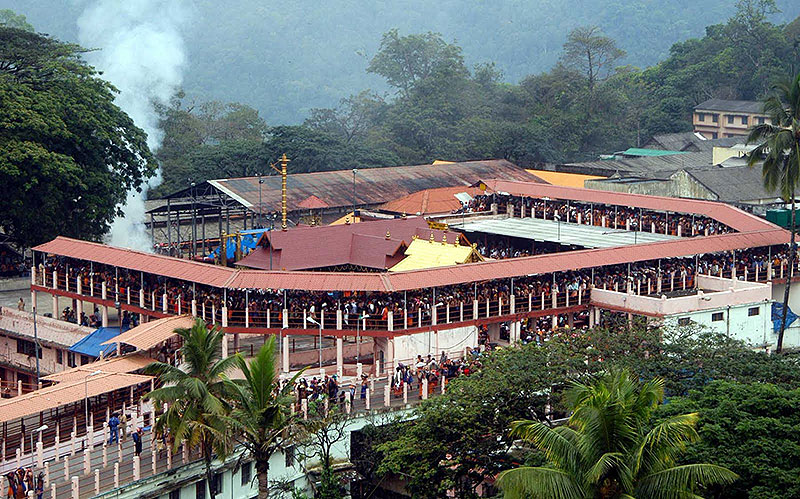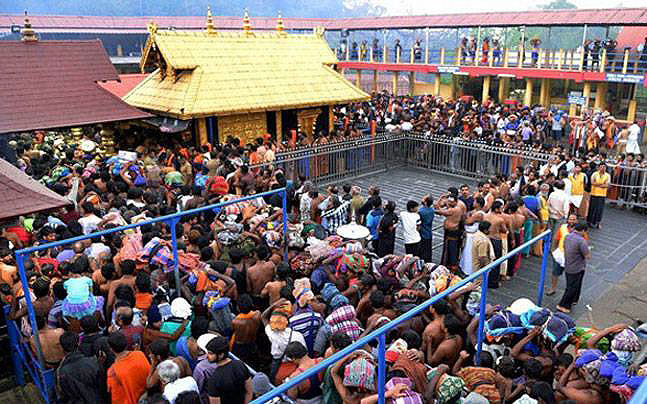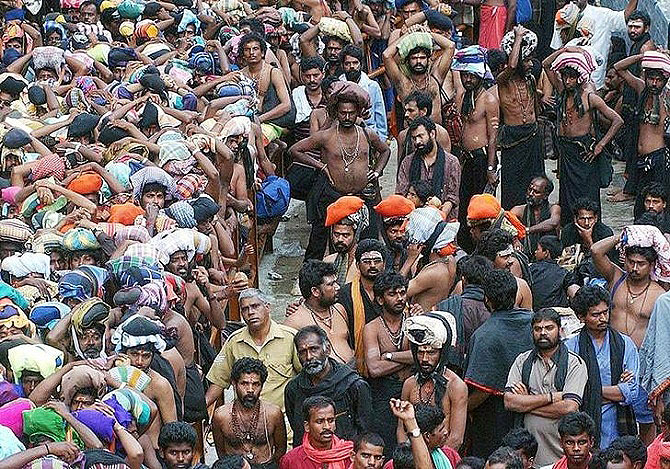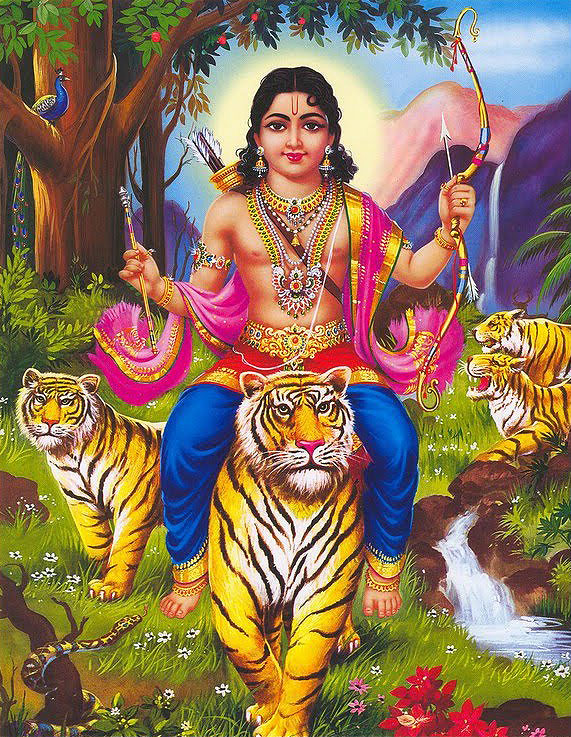
|
You are on the page: Home page ➤ Photo galleries of India ➤ Kerala ➤ Sree Dharmasastha temple, Sabarimala
|
 |
 |
Sree Dharmasastha temple, Sabarimala
65 kms east of Pathanamthitta is the temple of Dharma Sastha perched on the Sabari Hill. It is the most renowned pilgrim centre in India.
The presiding deity of the temple is Sree Dharma Sastha. The Shrine faces to the east. Near the main temple is situated the shrine of Malikapurathamma who is considered as a demi- Goddess. Another demi-God is Sree Ganapathy. Besides, the presence of Vavaru Swamy and Kadutha Swamy is also in existence near the temple.
It is said that Parasurama reclaimed Kerala from the sea. After that he brought Brahmins from outside Kerala. The myth says that for their protection Parasurama founded 108 Sasta temples in Kerala and one among them is Sabarimala Dharma Sastha.
In the popular songs of ‘Theeyat’ relating to Sree Ayyappa, there are references of ‘Sabarimala Kavu’ which refers to Sabarimala.
 |
At one time in the past the temple belonged to the royal family of Pandalam. The ancestors of the Pandalam royal family were Pandya kings. At the time of Kayamkulam war Pandya Rajah favoured Sree Marthanda Varma. So he did not conquer Pandalam. But during the invasion of Tippu Sultan, Marthanda Varma wanted Pandalam Rajah to meet a share of his war expenses. Since the Rajah was not able to pay the money, Pandalam became a part of Travancore in the year 1820. Thus Sabarimala temple which was under the jurisdiction of Pandalam Rajah came under the rule of Travancore.
The literature of ‘Sangam’ period reveal that hero worship was very common among people. Kannaki who attained divinity through hero worship became the Goddess of Kodungallur. So also in the case of Ayyappan who attained divinity might have become one with the idol that was placed by Parasurama at Sabarimala for the protection of Kerala. Perhaps this mythological finding may contain some truth. Before and after the ‘Sangam’ period there occurred changes in worship and rituals based on the belief of the people.
 |
According to the legend Sree Ayyappa was the son of Mohini by Lord Parama Siva. At the time of churning the ocean of milk, Maha Vishnu disguised himself as an enchanted woman Mohini to take away the Amritha from the demons. When Parama Siva saw this charming woman he fell in love with her and in their union a baby-boy was born. But she left the baby in a forest and disappeared.
One day Pandalam Rajah went for hunting with a few attendants. In the forest they saw a handsome boy. The Rajah took the boy and brought him to the palace. Since the boy had a bell on his neck he was named ‘Manikandan’. The boy was brought up at the palace with all royal facilities. He grew big enough to be trained in archery and weapon fighting. He was also taught Vedic scriptures. He became the apple of the king’s eyes. So he decided to make him the next heir of his throne.
Realising the intention of the king the minister approached the queen and told her that her own son had the right to become the next Rajah and it was improper and injustice to allow Manikandan, an orphan, to become the king. The queen made out the seriousness of the situation. As a mother she wished for her own son’s future and well being. She determined that she would not allow Manikandan to become the next Rajah. The cunning minister suggested a plan to overcome the situation. The queen soon fell ill. The palace physician was sent for. As instructed by the minister, the physician prescribed that the queen would be well if she could drink the medicine in the milk of a tigress. The minister then boldly told the others that Manikandan would be a suitable person to bring the milk.
On hearing this Manikandan expressed his desire to go to the forest. He also told his parents that he was strong enough to do such a deed and consoled his mother who was shedding crocodile tears. Eventually the Rajah with a broken heart, gave his consent.
 |
Soon after he got the permission to go to the forest, he bade farewell to his parents. The next day he came riding on a tiger followed by a number of them. The minister was bewildered at the sight. The inmates of the palace were quite afraid and they prayed for help. The minister did not know what to do. Manikandan wanted the minister to milk as much milk they wanted. The queen was ashamed of her own folly. She repented and shed tears profusely. Manikandan consoled her. Now, the Rajah understood that Manikandan was not an ordinary man and realised that he possessed divine qualities. Then Manikandan explained to his parents what they should do for him. As requested by him, the king built a temple for the Divine at Sabarimala.
The temple is situated in an area of 65 acres. Formerly it was opened only on two occasions, one for Mandala pooja and the other for Makara Vilakku, taking into consideration that the temple was situated in a dense forest having a large number of wild animals especially tigers and elephants. Due to the enormous increase in the number of devotees every year, some changes were made in the opening of the temple. Accordingly the temple will remain open on the first day to the 5th of the Malayalam months, Mandalam 41 days from Vrichikam 1st (November / December), before Makaram 1st 9 days (January / February), before Medam 1st 4 days (April / May) and Atham, Thiruvonam, Uthradam days in Edavam (May / June).
The installation day is ‘Atham’ in the month of Edavom. The opening schedule may change in future due to the enormous rush of devotees.
The temple was partly consumed by fire twice. The second fire broke out in 1125 M.E. But on both occasions the idol remained unhurt. Then the temple was renovated as we see it at present.
It is believed that Sree Dharma Sastha has been the protector of 18 hills. Those 18 hills are represented by 18 steps to the shrine. Each step has got its own story to tell. Offerings are made for those hills. It is known as ‘Padi pooja’, which is performed by the priest of Thazhamon Illom.
The ceremonial festival of the temple begin on the day of ‘Atham’ in Vrichikom with the hoisting of the flag. It lasts for ten days, and comes to a close with the divine bath at Pamba.
There are many ritualistic and customary observances to be followed by the devotees, the details of which cannot be described in a small book like this.
Some people believe that the original place of the deity was at Ponnambalamedu, some 15 kms from Sabarimala. Here there exists an altar on which camphor is lighted and it is known as Makara Vilaku. In the remote past Parasurama founded a Sastha temple at Ponnambalamedu and during those days in the evenings forest Goddess would come there and kindle the lamps. How wonderful! Since then the process has been continuing, the Divine light of which can be seen in the evening of the first day of Makarom (January / February) every year, and it is popularly known as Makara Jyothis.
 |
|
|